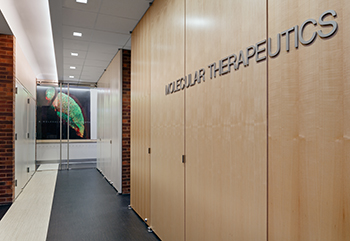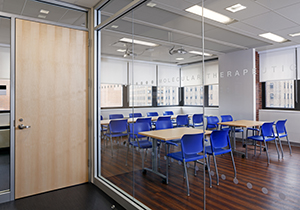Stonehill & Taylor Advance Contemporary Laboratory Design
 NEW YORK — The recently completed renovation of the Molecular Therapeutics laboratory in the Kolb Building of the New York State Psychiatric Institute is a model of the changing waves in laboratory design. The 10,500-square-foot laboratory leaves behind old notions of fixed laboratory design for more flexible spaces that model contemporary office spaces. An accommodating conference space and incidental meeting areas were designed to create a welcoming and relaxed environment for researchers to create innovations in the molecular sciences.
NEW YORK — The recently completed renovation of the Molecular Therapeutics laboratory in the Kolb Building of the New York State Psychiatric Institute is a model of the changing waves in laboratory design. The 10,500-square-foot laboratory leaves behind old notions of fixed laboratory design for more flexible spaces that model contemporary office spaces. An accommodating conference space and incidental meeting areas were designed to create a welcoming and relaxed environment for researchers to create innovations in the molecular sciences.
In this Q&A, Green Building News talks to Henry Meltzer, executive vice president and principal-in-charge of Stonehill Taylor’s health/sciences group, about the move to a more light-filled and collaborative laboratory space.
Q: What are some of the reasons behind this shift to a more office-like atmosphere in laboratories?
Meltzer: The shift is not specifically laboratories moving towards an office atmosphere; there is a larger shift in all workspaces. On a macro level, work spaces in all fields are moving towards a collaborative environment to foster teamwork and enhance brainstorming sessions. The reasoning behind this shift in wet labs is two-fold; one is the need for collaboration within in the workspace, and the other caters to the phased process of grant-funded research within these facilities. For the researchers to be able to seamlessly move between projects, the facility must allow for this flexibility. Kolb caters to this need, as the benches are flexible and not fixed, with mobile cabinets, height adjustable tops and “umbilical” utility connections at ceiling.
Q: What former laboratory design trends are now considered outdated or obsolete?
Meltzer: There is the growing trend to move away from built-in or fixed benches to movable ones. Research is also moving away from the wet lab, as there is a growing demand for dry or computational lab settings.
 Q: Can you describe your work on the Lawrence G. Kolb Research Laboratories?
Q: Can you describe your work on the Lawrence G. Kolb Research Laboratories?
Meltzer: We recently completed this 10,950-square-foot laboratory in the KOLB Building of the New York State Psychiatric Institute. With the aim of creating a comfortable research and collaboration environment for scientists doing fly research as part of molecular therapeutics, our firm employed a warm, welcoming style for the learning areas and highly technical expertise for the lab areas.
The reception area serves as a branding platform for the facility. Borrowing from the firm’s hospitality expertise, the sophisticated reception has a combination of wood-paneled and existing exposed-brick walls. Our team used images provided by the principal investigator as wall art, featuring close-up views of colorful microscopic imagery, including those of the fruit flies. These images aim to highlight the beauty of the field for the working scientists and visitors alike.
The public spaces include a flexible conference space with a pantry wall and classroom that can be easily partitioned by moving walls. Hallways also serve  as incidental meeting areas to encourage interaction and research within the facility in a less structured way. The marker board cladding and flexible leather stools allow scientists to gather and discuss and exchange ideas.
as incidental meeting areas to encourage interaction and research within the facility in a less structured way. The marker board cladding and flexible leather stools allow scientists to gather and discuss and exchange ideas.
The new research and education center includes open laboratories, as well as specialty procedure rooms for microscopy, electrophysiology, fly behavior and housing, and histology.
Q: How do you believe a more office-like feel affects researchers and their work?
Meltzer: The collaborative setting has facilitated a growth in communal activities and ideas sessions, while the single desk-like touchdown stations provide the researchers with the option to step away from the group to focus and realize a specific task generated in these collaborative settings.
Q: How have the researchers reacted to the space?
Meltzer: The researchers love the renovated space and are taking advantage of its communal features. The collaborative spaces have been extremely successful. Researchers immediately gravitated towards these open areas, even on the first day, confirming the need for these flexible work environments.
